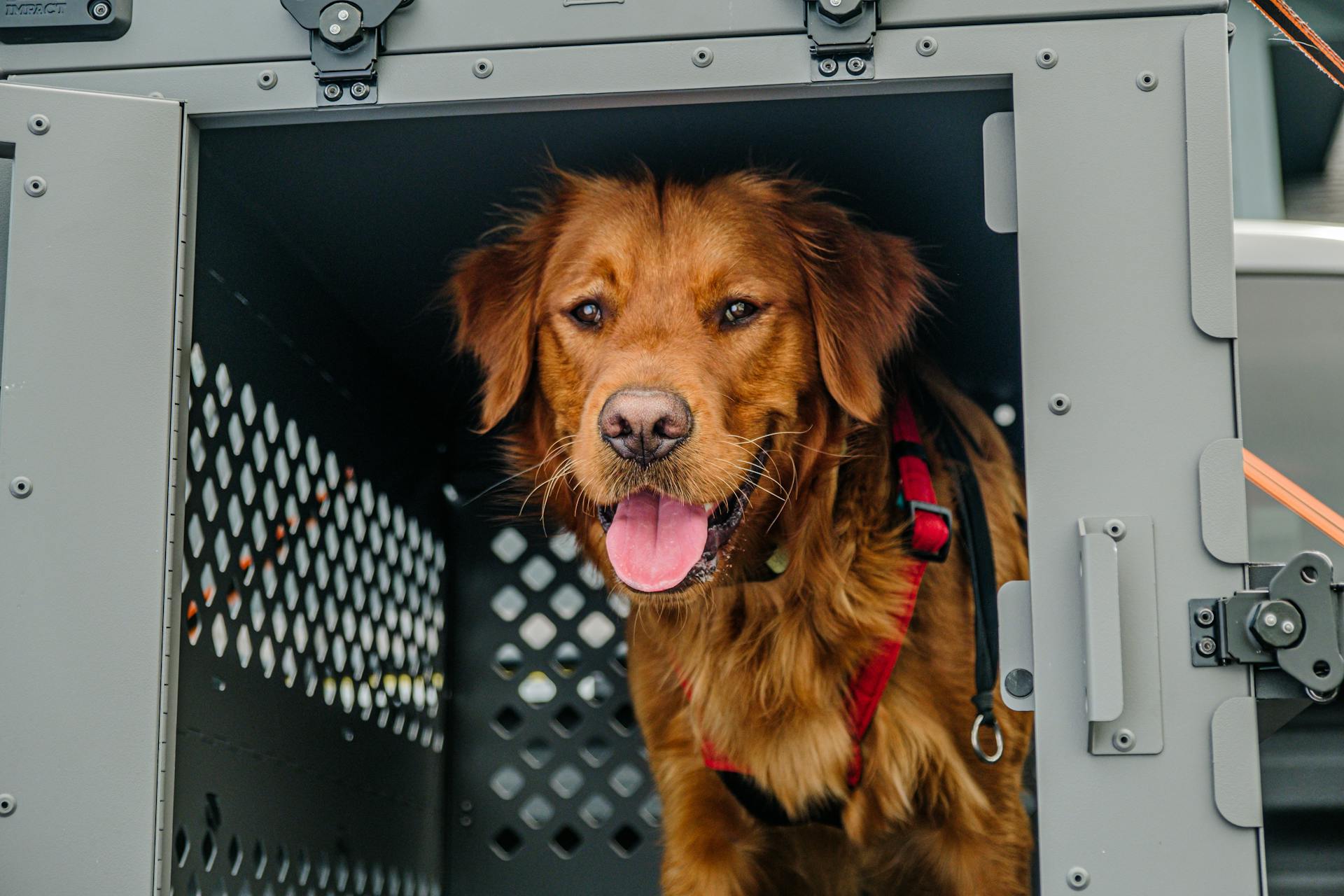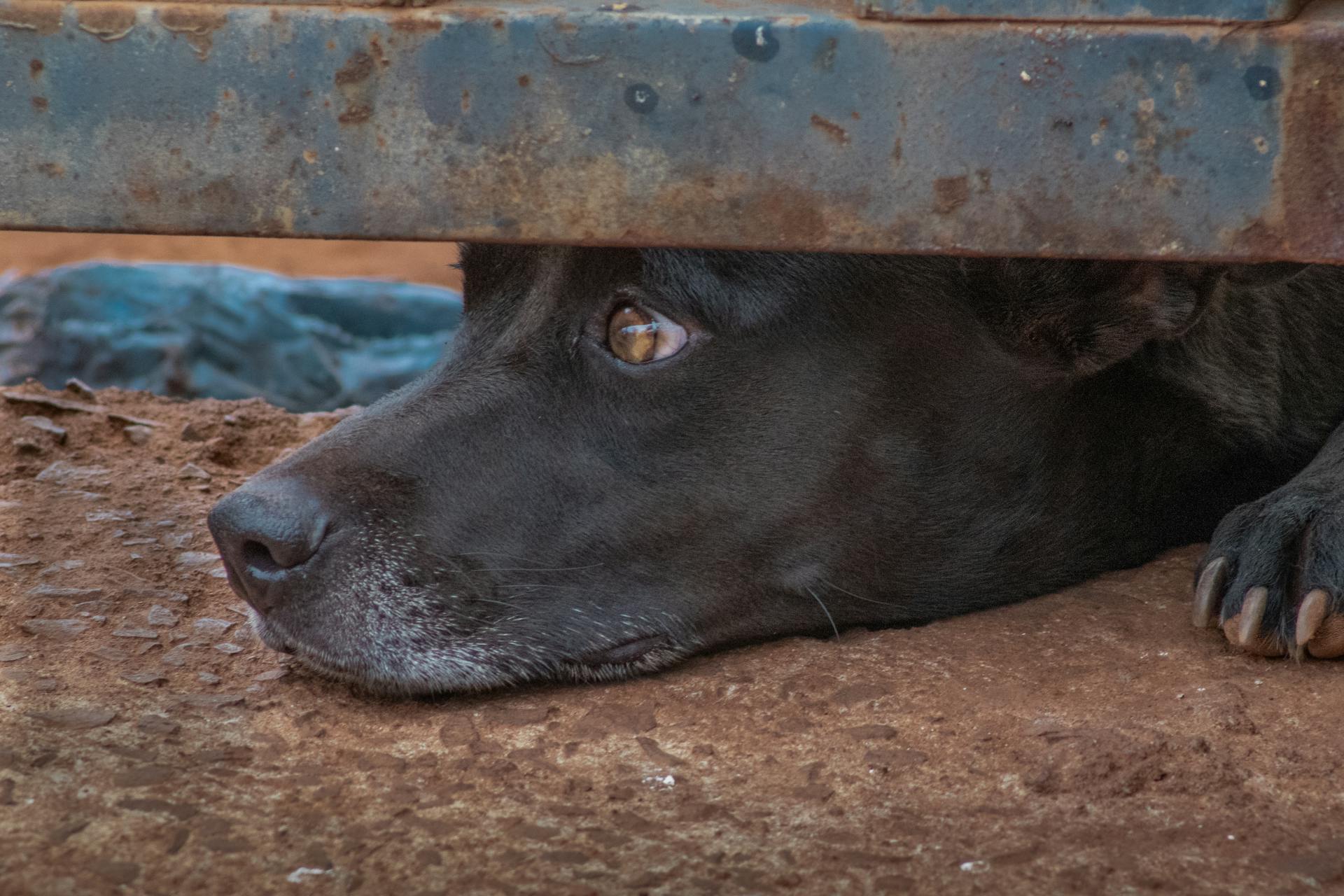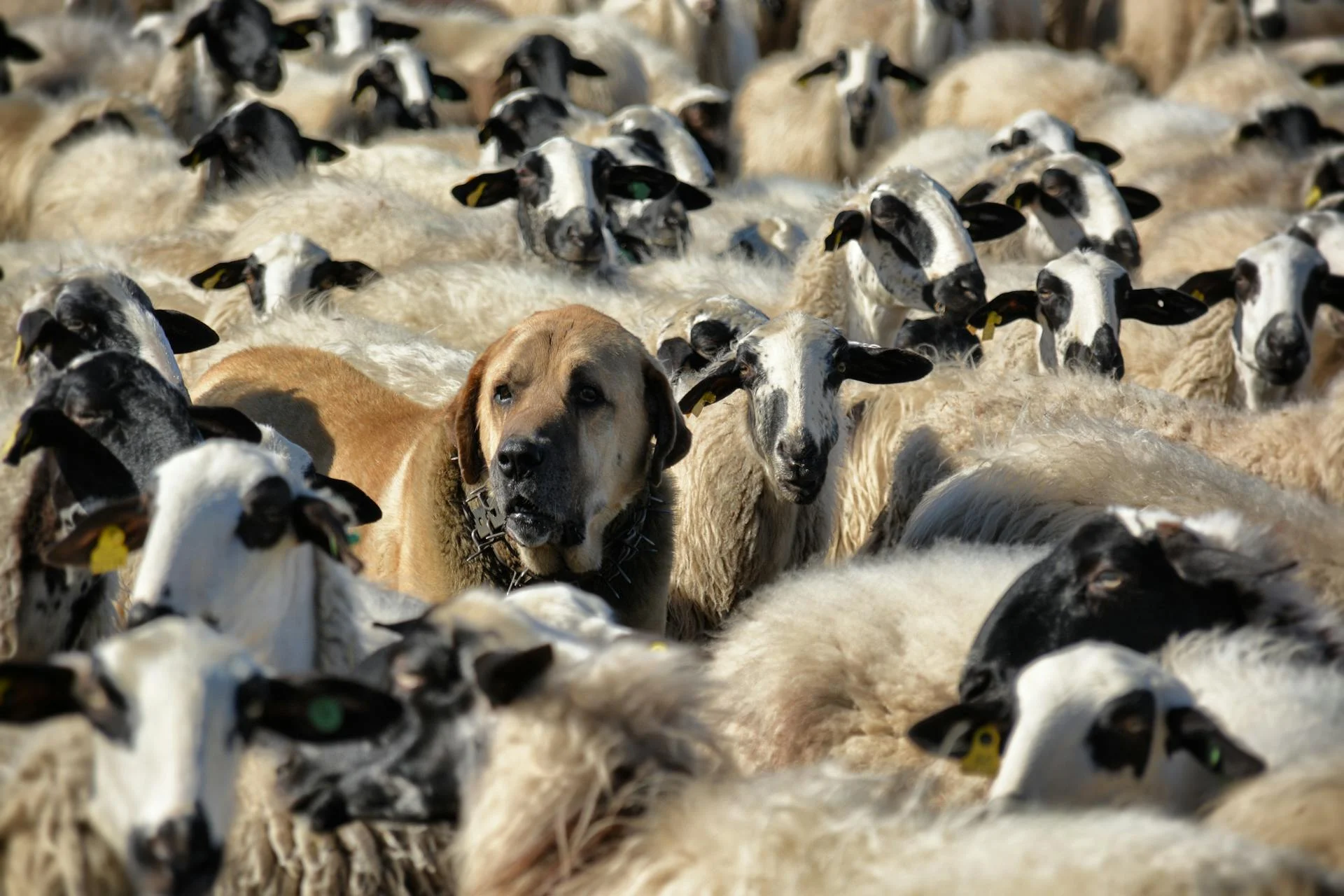
As a dog owner, it's heartbreaking to see your furry friend decline in health. Recognize the signs that indicate your dog's quality of life is decreasing.
Dogs often lose their appetite in the last stages of life, which can be a sign that they're no longer enjoying their food.
As your dog's health declines, they may become more lethargic and sleep more than usual, often waking up only to eat or drink.
Their once-sharp senses may also start to dull, making it harder for them to hear, see, or smell.
Some dogs may become more clingy or anxious as they sense their own mortality, while others may become more withdrawn.
Their gait may become more labored, and they may have difficulty standing or walking.
Take a look at this: How to Become a Dog Trainer for Service Dogs
Declining Health
Loss of appetite is a common sign of a dog's declining health, with a decreased interest in food or refusal to eat altogether. This can be a subtle change, but it's essential to notice.
Weight loss is another indicator, despite regular eating habits. If your dog is losing weight, it's a sign that something is amiss.
Lethargy is a clear sign of a dog's declining health, with a lack of energy or reduced activity levels. I've seen dogs go from being energetic to lethargic in a matter of days.
Difficulty breathing is an emergency, with labored breathing or shortness of breath. This is a sign that your dog needs immediate attention.
Changes in behavior are also a warning sign, including increased aggression, confusion, or disorientation. Be aware of these changes and consult with a veterinarian.
Here are some common signs of a dog's declining health:
- Loss of Appetite
- Weight Loss
- Lethargy
- Difficulty Breathing
- Changes in Behavior
- Incontinence
- Anxiety and Discomfort
Incontinence is a sign of a dog's declining health, with loss of bladder or bowel control. This can be a challenging issue to deal with.
Anxiety and discomfort are also signs of a dog's declining health, with visible signs of anxiety or pain, such as whimpering or restlessness.
Making the Decision
You know your dog best, and you'll know when it's time to make a difficult decision. It's not always easy to see the signs, but as Rex's owner noticed, a deteriorating condition can be a clear indicator that it's time to intervene.
Saying goodbye to your dog is a very personal and private thing, and each person does it in their own way. It's a moment that requires love, care, and compassion.
If you're unsure about what to do, research online and find a vet who will make house calls. This can be a more comfortable and less stressful experience for both you and your dog.
It's essential to spend quality time with your dog in their final hours, saying goodbye in a way that feels right for you both. This could be a quiet moment at home or a visit to a peaceful location.
Here are some things to consider when making the decision:
- Consult with your veterinarian about the best course of action.
- Discuss the logistics of euthanasia, including scheduling and location.
- Decide whether you want to bury your dog or have them cremated.
Ultimately, the decision is yours, and it's essential to prioritize your dog's comfort and well-being.
Veterinary Care and Treatment
As your dog's body weakens, veterinary care becomes crucial for their well-being. A veterinarian can assess your dog's condition and provide pain and anxiety management strategies.
Regular communication with your vet is essential to understand the outward signs of the disease process and make informed decisions about your dog's care. They may recommend therapies or medications to alleviate symptoms and improve quality of life.
Your dog may stop responding to treatments and medications as their body wears out, requiring adjustments to their care plan. A dog with arthritis may need additional pain medications, or a dog with diabetes may require frequent insulin dose changes.
Temperature Regulation Issues
Dogs that are sick, aging or dying often have trouble regulating their body temperature.
In warmer regions or during summer months, it's essential to provide your dog with a shady place to rest and easy access to water.
Dogs in cooler climates need a warm and cosy bed and blanket, or a warm spot in the sun to sleep.
If you live in an area with extreme temperature fluctuations, it's crucial to monitor your dog's temperature regulation and adjust their environment accordingly.
Dogs that are struggling to regulate their temperature may exhibit signs of distress, such as panting, pacing, or restlessness.
Veterinary Care

Seeking veterinary care is crucial when dealing with a dying dog. A veterinarian can assess your dog's condition, provide pain and anxiety management strategies, and offer guidance on end-of-life decisions.
A veterinarian may recommend therapies or medications to alleviate symptoms and improve quality of life. Regular communication with the vet during this stage will help to ensure your understanding of the outward signs of the disease process.
Your dog may stop responding to treatments and medications that had previously kept him happy and healthy. A dog with arthritis may require additional pain medications, or a dog with diabetes may require seemingly endless insulin dose changes.
A veterinarian can help you navigate these challenges and find ways to improve your dog's quality of life. They can also provide guidance on end-of-life decisions and support you through this difficult time.
Comfort and Care
As your dog's health declines, it's essential to prioritize their comfort and care. A veterinarian can assess your dog's condition and provide guidance on end-of-life decisions, which can be a huge relief.
Regular communication with your vet is key to understanding your dog's symptoms and making informed decisions about their care. By working together, you can ensure your dog's well-being throughout their journey.
Creating a comfortable environment for your dog is a practical way to show them love and care during this challenging time. Consider providing a warm and cozy bed, and make sure they have access to palatable food, such as canned food or plain cooked chicken.
It's also crucial to stick to your usual routines as much as possible, so your dog feels secure and familiar. If long walks are no longer an option, spend quality time sitting together instead.
Here are some specific ways to make your dog's last days comfortable:
- Keep your dog warm and comfortable with a cozy bed and resting spot.
- Offer palatable food, such as canned food or cooked chicken, to make mealtime enjoyable.
- Respect your dog's preferences for company or alone time.
- Stick to familiar routines and schedules to provide a sense of security.
- Consult with your veterinarian about medications to alleviate your dog's symptoms.
- Tell your dog it's okay to go and let them know they're loved and cherished.
By following these tips and working closely with your veterinarian, you can make your dog's final days as comfortable and loving as possible.
The Final Stages
As your dog approaches the end of their life, you may notice a change in their behavior and physical condition. They may become lethargic, sleeping more and showing less interest in activities they once loved.
Support your dog by providing comfortable places to rest around the house, with toys and their favourite blankets. This can help them feel more at ease during their final stages.
Irregular breathing patterns can also be a sign that your dog is nearing the end of their life. You may notice open-mouth breathing or periods of stopped breathing, followed by a resumed breath.
Extreme Fatigue
As your dog's age catches up with them, you may notice a significant decrease in their activity levels. They may lie around all day without moving to another spot, and this place is often chosen for its seclusion.
It's not uncommon for dogs to slow down as they get older, but if you notice your dog is lying around more and more, it may be a sign that they're not just getting older, but also dying.
Extreme fatigue can be a sign that your dog's body is shutting down, and it's essential to provide them with a comfortable and safe environment. You can help your dog by making sure their food and water bowls are easily accessible, so they don't have to exert themselves too much.

Your dog may also need a boost to help them get up from laying on the floor, and you can use a sling or harness to help them in and out of the house. Eventually, they may be unable to maintain a standing position at all and may struggle to walk.
Breathing Difficulties
As your dog's body starts to shut down, breathing difficulties can become a major concern.
Abnormal breathing patterns can be a clear sign that your dog is struggling to breathe.
Your dog may start to breathe more shallowly, taking longer times between each inhale and exhale.
You may notice your dog's mouth is open while he's breathing, or he's stretching his head and neck out straight while the rest of his body remains still.
This can be an uneven display of laboured breathing, taking a longer time between each full inhale and exhale.
In some cases, your dog may stop breathing periodically and then resume again, which can be a sign of difficulty breathing.
This is an emergency situation that requires immediate attention.
Emotional Support
As your dog's health declines, you may notice changes in their emotional state. They may become more clingy and affectionate.
Dogs often sense their own mortality and may become more attached to their owners as a result. This can be a heartwarming experience, but it's essential to respect their boundaries and not overindulge them.
Some dogs may exhibit anxiety or restlessness in the final stages of their life, while others may become more lethargic. This can be a sign that they're uncomfortable or in pain.
It's common for dogs to seek out quiet, comfortable spaces to rest, often in areas where they feel safe and secure. This can be a sign that they're trying to conserve energy or manage their pain.
In some cases, dogs may become more vocal or restless at night, possibly due to discomfort or pain. This can be a challenging time for owners, but it's essential to provide them with a comfortable and supportive environment.
Frequently Asked Questions
What shuts down first when a dog dies?
When a dog nears the end of its life, its digestive functions are often the first to shut down, typically due to the liver and kidneys failing to function properly.
What to do on your dog's last day?
Spend quality time with your dog on their last day by engaging in low-key activities like cuddling, playing, or enjoying the outdoors together. Monitor your dog's comfort and energy levels to ensure a peaceful and enjoyable experience.
Sources
- https://www.foundanimals.org/saying-goodbye-to-your-dog-tips/
- https://www.goodbyegoodboy.com.au/post/dog-behaviour-before-death
- https://www.codapet.com/blog/end-of-life-care-how-to-help-a-dying-dog
- https://cloud9vets.co.uk/signs-a-dog-is-dying-what-to-look-for-and-how-to-read-them/
- https://www.dailypaws.com/living-with-pets/end-of-life-care/signs-dog-is-dying
Featured Images: pexels.com


